The Bay Area faces severe vehicle theft challenges, with five counties making up over 20% of California’s total thefts in 2023. Key defense strategies include layered security with physical locks, GPS tracking, and electronic immobilizers. Law enforcement has achieved an 85. 8% recovery rate through multi-agency operations and technology. Vehicle owners can protect themselves through security upgrades, proper documentation, and strategic parking. The combination of prevention methods and community involvement offers the strongest protection against theft. To tackle the issue effectively, it’s crucial for vehicle owners to stay informed about the latest theft trends and participate in community watch programs. By building a strong defense strategies, individuals can collaborate with local law enforcement and neighborhood associations to share information and resources. Consistent awareness and vigilance not only deter thieves but also foster a safer environment for everyone, enhancing the overall effectiveness of prevention efforts against vehicle theft.
Key Takeaways
- Install layered security with physical barriers like steering wheel locks and electronic measures like GPS tracking for comprehensive protection.
- Document all authorized drivers and maintain clear records for insurance claims to avoid coverage denials or liability issues.
- Utilize community alert systems and surveillance networks that connect with law enforcement for quick vehicle recovery.
- Implement anti-theft software updates and immobilizer systems, which have reduced theft claims by over 50% in vulnerable models.
- Park in well-lit, monitored areas with automated security systems, as Bay Area recovery rates exceed 85% with proper precautions.
Current Vehicle Theft Landscape in Bay Area Counties

Five Bay Area counties accounted for over one-fifth of California's vehicle thefts in 2023. Alameda County led with 11,151 thefts, representing more than half of the region's incidents. Santa Clara, San Francisco, San Mateo, and Marin counties followed with decreasing numbers.
Urban crime patterns show concentrated theft activity in densely populated areas like Oakland and San Jose. Economic pressures and unsecured vehicles create opportunities for thieves. Despite these challenges, theft prevention efforts have yielded positive results, with recovery rates averaging 85.8% across the state. Alameda County demonstrated particular success, recovering 93.5% of stolen automobiles and 90.2% of SUVs. Cargo theft remains a specific concern, with 1,296 cases linked to organized retail crime activities throughout the region.
Essential Security Modifications for High-Risk Models
Modern vehicle security requires a layered approach combining physical and digital protections. Essential upgrades include reinforced door locks, smart interlocks that verify driver identity, and GPS tracking systems that monitor vehicle location in real-time. These core security modifications help protect high-risk models from both opportunistic thieves and sophisticated criminal operations.
Lock System Hardware Upgrades
Well-designed lock system upgrades serve as the foundation of vehicle security. Modern lock system innovations include Thunderbolt deadbolts and Meroni UFO locks that integrate directly into door structures. These provide enhanced hardware durability against drilling and sawing attempts.
Slick Locks offer vehicle-specific solutions that maintain uniformity across sliding and rear doors without requiring drilling. Legend SecuriLocks and Master Lock reinforced hasps feature steel alloy construction that resists external manipulation. For cargo vans, UFO3 Smart Duo Locks conceal attachment points behind secure panels.
These physical barriers work alongside electronic security features like encrypted proximity sensors and walk-away locking systems. Together, they create multiple layers of protection against unauthorized access while maintaining practical daily operation.
Anti-Theft Software Protection
Recent software updates have transformed vehicle security for high-risk models. Hyundai and Kia vehicles from 2011-2022 show remarkable improvements after implementing theft deterrents. Software upgrades reduced theft claims by 53%, requiring owner verification for vehicle starts.
| Security Feature | Impact |
|---|---|
| Immobilizer Update | 64% fewer thefts |
| Extended Alarms | 30s to 1min alert |
| Key Authentication | Rolling encryption |
| Remote Start | 24hr deactivation |
| VIN Etching | 90% recovery rate |
While 60% of eligible vehicles received updates by July 2024, challenges remain. Thieves now target these vehicles differently, resulting in 61% higher vandalism claims. Basic trim models without factory alarms cannot receive updates, leaving them vulnerable. The software requires dealership installation for luxury models, creating access barriers for some owners.
Tracking Device Implementation
While software updates offer one layer of protection, tracking devices provide direct vehicle monitoring capabilities. Modern GPS systems deliver multiple tracking device benefits through secure, tamper-resistant installations that connect to vehicle diagnostics. Bay Area fleet managers can monitor vehicle locations in real-time while maintaining strict data privacy standards.
Key installation challenges require careful consideration:
- Devices must be properly hardwired with anti-tamper fusing and power isolation to prevent unauthorized removal
- Installation requires shock-resistant housing that withstands extreme temperatures while maintaining GPS accuracy
- Post-installation testing must verify 30-second GPS lock acquisition and proper geofencing functionality
When properly implemented, these systems enable instant alerts for unauthorized movement, speed violations, and battery tampering while complying with local data retention regulations.
Proven Theft Prevention Equipment and Tools
Multiple layers of security equipment provide the strongest defense against vehicle theft. Modern theft deterrence tools include steering wheel locks, brake pedal locks, and wheel clamps that create visible barriers. Kill switches interrupt the flow of electricity to prevent engine start. Advanced vehicle security innovations like biometric scanners add sophisticated protection.
Electronic immobilizers built into key fobs prevent hot-wiring by requiring coded signals. Security cameras and motion-activated lights in parking areas deter criminals. Locking fuel caps and hood locks block access to critical components. Vehicle alarm systems with multiple sensors detect tampering. These physical and electronic barriers work together to greatly increase the difficulty of stealing a vehicle, making thieves more likely to move on to easier targets.
Law Enforcement Response and Recovery Statistics
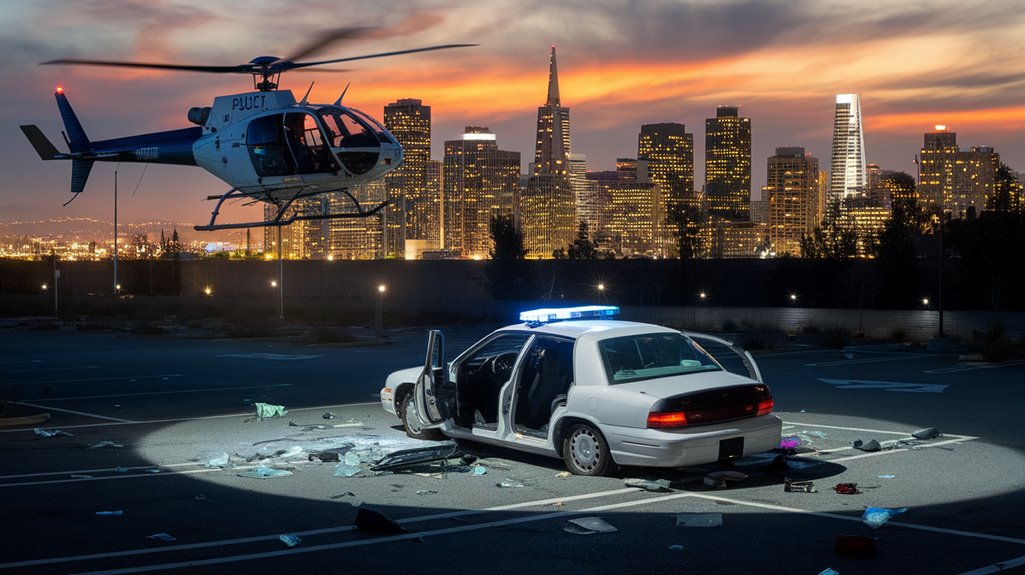
Recent law enforcement efforts show strong results in vehicle theft prevention and recovery across the Bay Area. Multi-agency operations have recovered over 2,200 vehicles and seized 110 illegal firearms in Oakland since February 2024. The combined efforts of CHP and local police demonstrate significant impact through increased arrests, vehicle seizures, and targeted enforcement operations that reduced visible crime by 57% in high-risk areas.
Multi-Agency Recovery Operations
Law enforcement agencies achieved significant results through coordinated vehicle recovery operations in 2024. Multi-agency collaboration between CHP, Oakland PD, and Alameda County proved highly effective. The operations included extensive recovery funding of $510 million annually, showing strong financial commitment to combat vehicle theft.
Key accomplishments included:
- Recovery of 2,213 stolen vehicles by October 2024
- 1,125 arrests between February and October
- Seizure of 110 illegal firearms by October, up from 47 in June
The Foreign Export and Recovery (FEAR) program played an essential role, intercepting stolen vehicles at ports. Partnership with Mexican authorities resulted in approximately 200 monthly vehicle recoveries. Task forces integrated federal, state, and private entities to maximize effectiveness, including partnerships with insurance companies.
Enforcement Impact By Numbers
Hard data demonstrates the significant gains made by enforcement operations throughout 2023-2024. The numbers reveal clear success in vehicle recovery efforts, with 2,213 stolen vehicles recovered through CHP operations since February 2024. Enforcement strategies led to a 44% increase in recoveries compared to previous periods.
The impact extends beyond vehicle recovery. Law enforcement made 1,125 arrests related to property crimes in 2024, while firearms seizures jumped 188%. Oakland's enhanced enforcement strategies helped combat the region's high theft rates, where San Francisco alone reported 7,135 vehicle thefts through December 2023. The installation of 400 license plate readers and Flock cameras strengthened monitoring capabilities. Current data shows these combined efforts are making measurable progress in reducing unauthorized vehicle use.
Strategic Parking Practices for Urban Areas
Modern cities face growing pressure to manage limited parking spaces efficiently. Smart parking systems use IoT sensors and real-time data to optimize space utilization. Dynamic pricing adjusts fees based on demand, helping distribute vehicles across available spots.
Key strategies that cities implement include:
- Automated multi-level garages that maximize vertical space and reduce land use
- Real-time parking apps that let drivers find and reserve spots quickly
- Integrated platforms that connect parking management with broader urban systems
These practices help cities prevent unauthorized parking while improving legitimate access. Smart meters and enforcement systems track usage patterns and guarantee compliance. Cities like Singapore and Los Angeles demonstrate how technology-driven solutions can transform urban parking management. The result is better space utilization and reduced search times for drivers.
Insurance Coverage and Claims Process
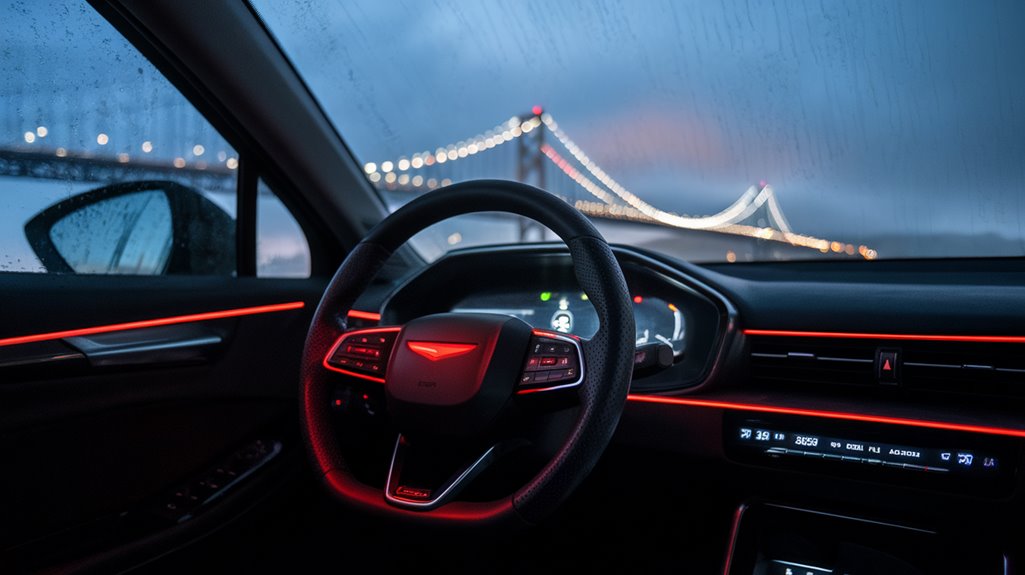
Insurance policies vary in how they handle unauthorized vehicle use, with most standard coverage reducing or denying claims for non-listed drivers. Filing a successful claim requires clear documentation of the driver's authorization status and prompt reporting to both insurance and law enforcement. Vehicle owners should review their policies carefully, as unauthorized use incidents often lead to increased premiums and may require additional coverage riders to protect against future losses.
Coverage Types and Limits
Vehicle owners need to understand their insurance coverage types and limits. California law sets mandatory minimum liability limits that all drivers must carry. These coverage types protect against both authorized and unauthorized use of vehicles, with specific conditions. Additionally, it is crucial for vehicle owners to be aware of the implications of driving under the influence, particularly in light of California’s strict regulations. The state enforces stringent policies that align with a zero tolerance DUI laws overview, ensuring that any instance of driving while impaired carries severe penalties. Understanding how these laws interact with insurance coverage can help drivers make informed decisions and maintain compliance with state requirements.
Key insurance requirements include:
- $30,000 per person for bodily injury
- $60,000 total bodily injury coverage per accident
- $15,000 for property damage
Insurance policies typically provide broader coverage for permissive use situations, where drivers have express or implied permission to operate the vehicle. However, coverage may be reduced or denied in cases of unauthorized use. When claims exceed policy limits, vehicle owners face personal liability for remaining damages. Understanding these coverage types and liability limits helps owners protect themselves from financial exposure and legal complications.
Filing Claims Successfully
Successful insurance claims start with proper documentation and timely reporting. Vehicle owners must submit claim documentation within 30 days of the incident, including police reports, repair estimates, and witness statements. The process requires clear ownership verification through vehicle titles and registration papers.
Proving unauthorized use demands evidence that the borrower lacked permission to drive the vehicle. This includes statements from witnesses and documentation showing no history of lending the car to that person. Insurance companies examine any prior access to determine if implied consent existed.
For loss-of-use claims, owners can recover costs like rental cars or rideshare expenses. These must be filed separately from the main claim. Claims should include proof of repair delays, parts availability issues, and reasonable timelines for vehicle restoration.
Rate Impacts After Theft
Rising theft rates in the Bay Area have pushed insurance costs to new heights. The average full coverage now costs $1,948 annually, reflecting increased risks in high-crime zones. Without extensive coverage, vehicle owners face steep out-of-pocket expenses for theft-related damages.
Insurance consequences after a theft incident often include:
- Higher premium rates based on ZIP code crime statistics
- Increased deductibles for glass and hardware damage claims
- Additional costs for rental car coverage during claim processing
Even with theft deterrents like kill switches and VIN etching, insurance rates continue climbing due to the 200% surge in break-ins. Smart vehicle owners can offset these increases by bundling policies and installing security upgrades. However, parking in high-risk areas near airports or dining hotspots may still trigger rate adjustments.
Community Alert Systems and Reporting Methods
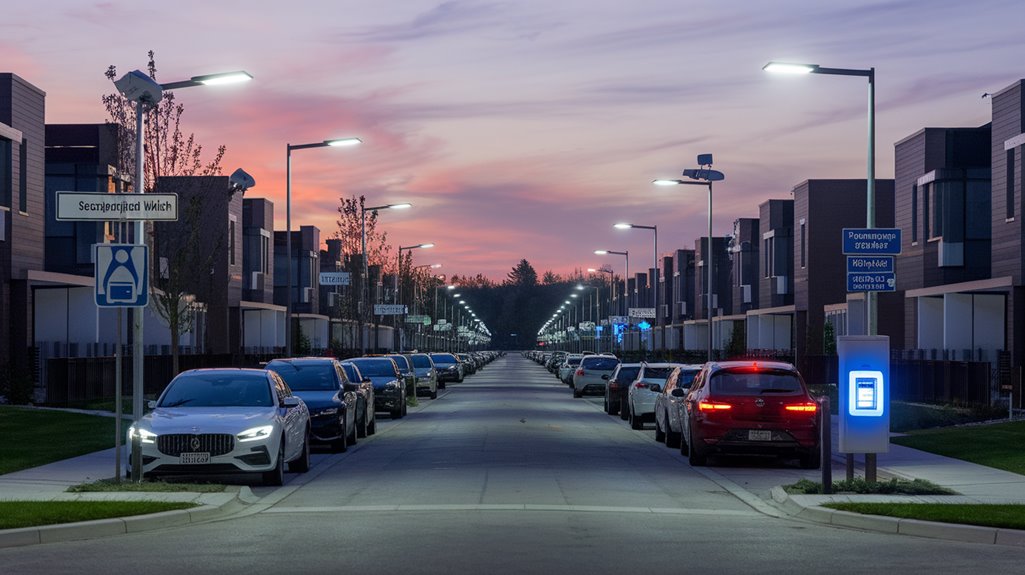
Modern alert systems play an essential role in preventing vehicle theft. San Francisco's network of 400 ALPR cameras across 100 intersections enables real-time detection of stolen vehicles. This community surveillance system connects to Flock Safety's network, used by over 5,000 U.S. law enforcement agencies.
The system's effectiveness is evident in San Francisco's recent statistics, showing a 40% decrease in larceny theft and 7% reduction in motor vehicle theft. Hotlist-based alerts instantly notify law enforcement about flagged license plates linked to crimes or Amber Alerts. Citizen engagement through reporting suspicious activities strengthens these technological measures. To protect privacy, the system includes strict controls like facial recognition bans and regular data purges, ensuring responsible use of surveillance technology.
Vehicle Recovery Protocols and Success Rates
Coordinated vehicle recovery efforts in the Bay Area demonstrate notable efficiency gains since 2019. Recovery teams now clear 89% of freeway incidents within 60 minutes, cutting previous clearance times in half. Joint CHP/MTC taskforces achieve high success rates, recovering 82% of diverted vehicles within 48 hours.
Bay Area vehicle recoveries hit record speeds, with teams clearing most freeway incidents in under an hour through enhanced coordination.
Key success metrics include:
- Third-party partnerships handle 75% of non-commercial vehicle recovery
- Active recovery protocols prevent 1,200 secondary collisions annually
- Anonymous tips lead to 19% of unauthorized vehicle recoveries
These improvements yield significant benefits beyond faster clearance times. The streamlined vehicle recovery process reduces emissions by 15% compared to old methods. Despite these gains, uninsured vehicles remain a challenge, accounting for 31% of unauthorized stops and complicating recovery efforts.
Economic Impact on Bay Area Vehicle Owners
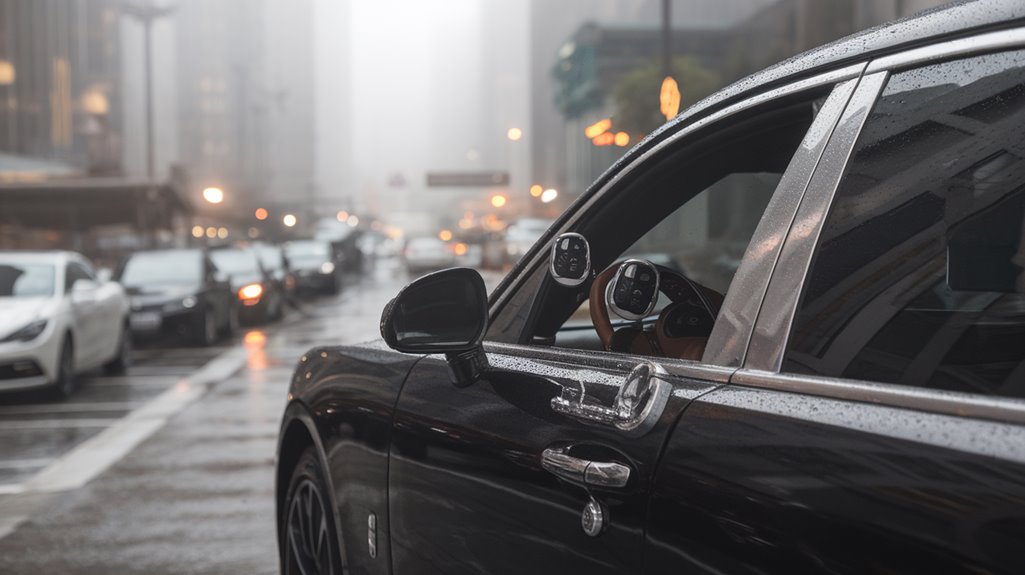
The economic toll of unauthorized vehicle use extends far beyond simple recovery costs. Bay Area vehicle owners face mounting financial pressures from both direct theft losses and broader regional congestion impacts. Theft deterrence programs, like Vallejo's targeted enforcement using GPS-baited vehicles, have shown promising results with a 40% reduction in auto burglaries. These initiatives help protect owners' economic stability while reducing the $3.1 billion annual cost of traffic congestion in the region. When combined with SB 1's traffic reduction programs, vehicle owners can expect $982 million in yearly savings through improved safety and reduced congestion. Enhanced police patrols and surveillance systems have proven effective, with zero thefts reported during visible police presence compared to multiple incidents without deterrence measures.
Legal Consequences for Unauthorized Vehicle Use
State laws establish varying levels of consequences for unauthorized vehicle use across jurisdictions. Legal distinctions range from misdemeanors in Massachusetts and Ohio to felony charges when specific conditions are met. Defense strategies often focus on proving reasonable belief in authorization or challenging insufficient evidence. Penalties may escalate if the unauthorized use involves additional crimes, such as theft or reckless endangerment. In some cases, defendants argue mistaken permission, citing misunderstandings with vehicle owners. Similar to selfdefense laws and arrests, legal outcomes can depend on jurisdiction-specific interpretations and the evidence presented in court. Moreover, variations in state laws can lead to different interpretations and enforcement patterns, making it crucial for defendants to understand their local legal landscape. Some jurisdictions may exhibit leniency in cases involving genuine errors in judgment, while others may impose strict penalties irrespective of intent. Similarly, as seen with selfdefense claims in the bay area, the nuances of legal arguments can significantly influence the outcome of a case, highlighting the importance of tailored legal representation.
Key factors that determine severity of charges include:
- Duration of unauthorized use – extending beyond 48 hours can trigger felony charges
- Financial loss amount – damages over $1,000 elevate charges in most jurisdictions
- Victim status – cases involving elderly or disabled owners face harsher penalties
Juveniles typically face rehabilitation-focused consequences rather than incarceration. Successful defenses often involve documenting rental agreements, gathering witness testimony, or proving technical compliance with vehicle use terms. First-time offenders may qualify for pretrial programs or alternative sentencing options.
High-Risk Areas and Time Periods

Recent data from Bay Area law enforcement reveals distinct patterns in vehicle-related crimes. Analysis shows high risk neighborhoods like Bayview lead with 17 car thefts per 1,000 residents, while the Mission District faces both theft and carjacking challenges. These troubling statistics highlight the pressing need for targeted crime prevention strategies in these neighborhoods. In addition, law enforcement is grappling with the complexities of repeat offenders, as some individuals are on house arrest for fifth DUI charges, further complicating community safety. Local initiatives are being proposed to address not only vehicle thefts but also to support individuals caught in a cycle of addiction and crime. Additionally, police reports indicate that areas with higher rates of vehicle crimes often coincide with neighborhoods grappling with other forms of violence and property crime. To address these issues comprehensively, local officials are exploring innovative strategies, including house arrest options for DUI offenders, as a means of reducing repeat offenses and fostering community safety. Implementing such measures could potentially divert resources from the already strained law enforcement and judicial systems.
| Location | Risk Level | Key Concerns |
|---|---|---|
| Bayview | Highest | 287 thefts (2023) |
| Portola | High | 161 thefts, industrial lots |
| Mission District | High | Combined theft/carjacking |
For theft prevention, timing matters as much as location. Data shows 4-5 AM as peak theft hours. High-density areas with security cameras and garages report fewer incidents. The CHP's expanded patrols have proven effective, with 2,213 vehicles recovered since February 2024. Areas near highways and industrial zones require extra vigilance, particularly during post-holiday periods when sideshow activities surge.
Technology Solutions for Vehicle Protection
Modern vehicle protection extends beyond choosing safe locations and timing. Advanced coatings and vehicle enhancements now offer multiple layers of security against both criminal activity and environmental damage. These technological solutions make vehicles less vulnerable to tampering and unauthorized access.
Key protective measures include:
- Ceramic Pro nanoceramic coatings that shield against scratches, UV rays, and harmful contaminants
- KAVACA Ceramic Coated PPF with self-healing capabilities that seal micro-surface imperfections
- ULTIMATE ARMOR combinations that provide lifetime warranty protection, documented in Carfax reports
Professional installation using computerized templates guarantees precise coverage. Hydrophobic properties in window treatments improve visibility while reducing water spots. Pre-installation inspection confirms compatibility across different surfaces, from vinyl wraps to wheels, maximizing the effectiveness of these protective technologies.
Partnering With Local Authorities for Prevention
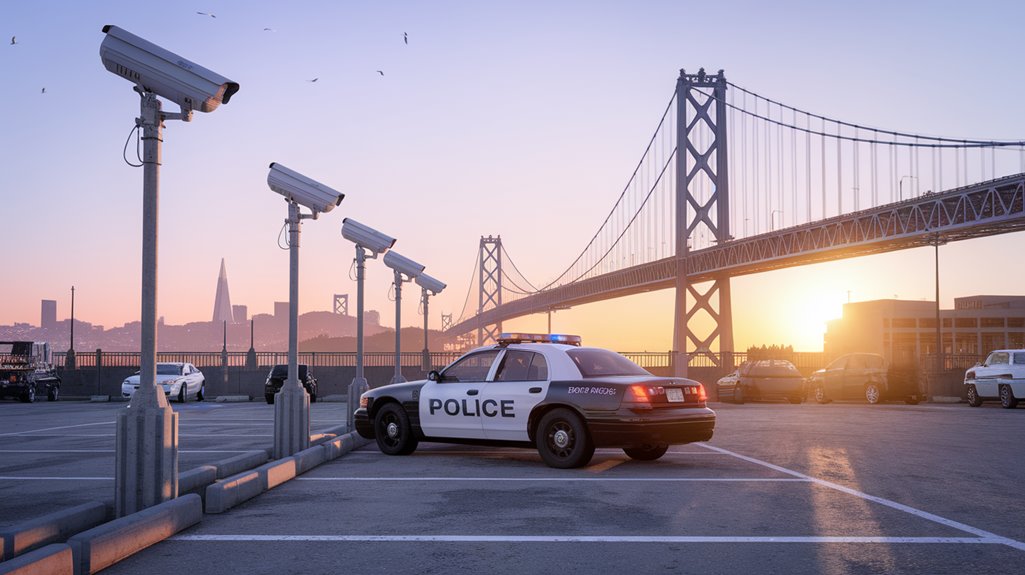
Working together with law enforcement can greatly reduce vehicle-related crimes. The Bay Area's coordinated approach between police departments, CHP, and businesses has shown promising results in crime deterrence. In 2024, SFPD and partner agencies disrupted 15 sideshows, down considerably from 72 in 2021.
Community cooperation plays an essential role through real-time reporting and evidence sharing. Residents can call 911 to report suspicious activities, while businesses participate in data sharing and surveillance programs. New laws support these efforts with stronger penalties, including extended vehicle impounds and possible forfeiture upon conviction. The results are clear – law enforcement seized 67 vehicles in 2024 related to reckless driving, while CHP recovered $13M in stolen goods through regional operations.
Frequently Asked Questions
How Can I Track My Stolen Vehicle if My GPS Tracking Device Fails?
When GPS tracking fails, several tracking alternatives can assist in vehicle recovery. Drivers can use cellular network triangulation through SIM tracking or enable smartphone location sharing. License plate recognition systems and security camera networks provide additional monitoring options. Community alerts through social media and neighborhood networks can help gather sighting reports. Checking with local law enforcement, towing companies, and reviewing nearby surveillance footage increases recovery chances.
What Steps Should I Take if Unauthorized Drivers Use My Vehicle Without Permission?
If someone uses a vehicle without permission, the owner should immediately contact police to report unauthorized use. This creates an official record for vehicle recovery and insurance claims. The next steps are filing a detailed theft report and documenting any damage with photos. It's important to avoid using the vehicle until cleared by authorities. Owners should also contact their insurance provider right away to start the claims process.
Are There Specific Anti-Theft Modifications for Electric and Hybrid Vehicles?
Modern anti-theft technology for electric and hybrid vehicles includes specialized immobilizers and GPS tracking systems. Electric vehicle modifications often focus on protecting valuable components like catalytic converters and charging ports. Silent starter systems prevent unauthorized use while avoiding false alarms. Popular additions include wheel locks, steering wheel barriers, and VIN etching on windows. Solar-powered alarm systems work well with hybrid vehicles since they don't drain the main battery.
How Do Carjacking Prevention Techniques Differ From Regular Anti-Theft Strategies?
Purposeful prevention prioritizes people over property when comparing carjacking tactics to theft deterrents. Carjacking defense focuses on active awareness and real-time responses, while anti-theft mainly uses passive security measures. Carjacking strategies emphasize driver safety through constant scanning, strategic parking, and escape route planning. Regular theft prevention relies more on physical barriers like locks and alarms. The key difference is the human threat element versus property protection.
Can Neighborhood Watch Programs Effectively Reduce Vehicle Theft in Residential Areas?
Research shows neighborhood watch programs can considerably reduce vehicle theft in residential areas. Through organized neighborhood engagement, these programs typically cut property crime rates by 16-26%. Community vigilance, combined with visible warning signs and structured reporting systems, helps deter thieves. Success depends on consistent participation and good communication with law enforcement. However, programs work best when residents stay actively involved and avoid volunteer burnout.
Conclusion
Vehicle theft in the Bay Area remains a game of cat and mouse, where car owners deploy increasingly clever gadgets while thieves keep upping their game. Like an awkward dance at a high school prom, both sides stumble through their moves – one installing fancy alarms, the other finding new ways around them. In the end, the best defense might just be parking that precious ride in Iowa.
